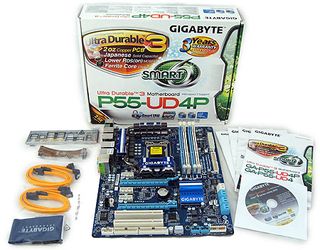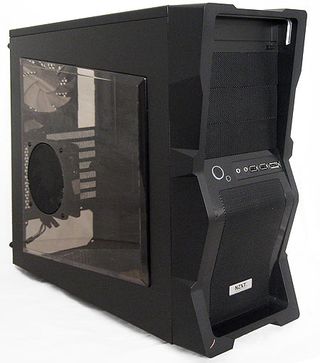System Builder Marathon, Dec. 2009: $1,300 Enthusiast PC
CPU, Motherboard, And Case

CPU: Intel Core i5 750
Intel's Core i5 CPU is similar to the LGA 1366 Core i7s we're already familiar with, but saddled by three main disadvantages: Hyper-Threading is unavailable, the chip's memory controller offers two channels instead of three, and the CPU is limited by a 16-lane integrated PCI Express controller, whereas X58 enables 36 lanes of its own second-gen PCI Express.


Read Customer Reviews of Intel's Core i5-750
Since Hyper-Threading and triple-channel memory offer arguably limited benefits in a number of applications, the only time we'd be concerned about selecting a Core i5 is if we plan to share those 16 PCIe lanes with more than two graphics cards. Testing has shown that two graphics cards can still perform exceptionally, even when limited to using eight PCIe 2.0 lanes each, so we're happy to employ the Core i5 for dual-card SLI or CrossFire setups, but not for triple- or quad-card configurations.
On the plus side, of course, compared to the Core i7 CPUs, is the price. The Core i5-750 2.66 GHz CPU costs $200, while the cheapest Core i7-920 2.66 GHz CPU weighs in at $80 more and won't offer a tangible performance boost over the i5 for most applications. Because we've chosen a simple two-card graphics configuration in CrossFire, the Core i5-750 is the obvious choice for this price bracket.
Motherboard: Gigabyte GA-P55-UD4P


Read Customer Reviews of Gigabyte's GA-P55-UD4P
Stay on the Cutting Edge
Join the experts who read Tom's Hardware for the inside track on enthusiast PC tech news — and have for over 25 years. We'll send breaking news and in-depth reviews of CPUs, GPUs, AI, maker hardware and more straight to your inbox.
When Thomas Soderstrom rounded up enthusiast-class P55 motherboards, the Gigabyte P55-UD4P scored his highest recommendation by offering high performance and good overclocking capabilities, coupled with low power consumption and a more-than-acceptable VRM temperature. At $170, it's not a budget board, but a full-featured enthusiast-class platform that will serve us well in this $1,300 machine.
PC Case: NZXT M59


Read Customer Reviews of NZXT's M59
Quickly running out of room in our budget, we had to find a case that didn't break the bank. Instead of choosing the Antec Three Hundred for a solid budget case, we thought we'd mix things up and try something new. We're fans of NZXT's Tempest case, so we gave its M59 a try.
We were very pleasantly surprised by the M59. The relatively low price provided a very stylish, good-quality case with quite a bit of room inside. While this price point only affords two 120mm fans, they were quiet and did the job.
However, the real treat is upgradeability. The top of the case can be fitted with two more 120 or 140mm fans so that hot air can be exhausted upward, just like the Tempest allows.
Current page: CPU, Motherboard, And Case
Prev Page System Builder Marathon: $1,300 Enthusiast System Next Page Video Cards And Power Supply-
Crashman Great build Don! The only thing I'd change is to use the RAM from the $2500 system! It's too bad you didn't have enough money left over to buy a big cooler.Reply -
noob2222 Very smoothe build, pretty limited with the 5850s with the pricing once past that, but this thing handles it well, esp since the cpu was lucky enough to stay fast while undervolted.Reply
Not all cpus are the same, this one compared to the $2500 build definatly shows it. Takes a bit of luck sometimes or bad luck. -
Tridec Just a thought, but why not use an I7 920 CPU, with an asrock x58 Extreme motherboard? I see a lot of people bought their I7 920 CPU for 199 dollars and the motherboard costs 170 dollars.Reply
Pair that up with OCZ 1333 platinum 7-7-7-24 memory, that can easily be overclocked to 1600 7-7-7-24 and you'll have a powerful system with 36 PCI-e lanes and loads of CPU overclocking room thanks to asrock's great motherboard. -
SpadeM Good article, and yes the quadfire setup was sweet back then!! I just have a question/suggestion to make, and if you find worthy of a replay I'd much appreciate it.Reply
Since you are willing to experiment with different setups, and since we see the problem with the Phenom in the application suite, why not try something more exotic like pairing a nvidia based card with the crossfire cards to act like a PPU / video transcoding accelerator (TMPEng supports CUDA at least to act as a filter). I don't know if this makes sense in a marathon build, but I'd like to see something like this benchmarked.
-
shubham1401 This is an excellent build.Reply
With an aftermarket cooler this build will be flawless.
Power Draw,Performance all were nice.
The case looks nice too. -
burnley14 I'm not especially interested in the gaming results per se, but this build certainly solidifies my choice to go with an Intel processor over AMD based on productivity benchmarks.Reply -
optional22 Aside from the video cards, this is essentially the same build as the $2,500 build recently posted performance-wise. What is the point?Reply -
kick_pixels Good system over all… an extra hard drive for backup is essential and the wiring needs some tiding up.Reply
-
cangelini More specifically, these guys are trying different things each time we do a round of SBMs--sometimes the results are great, and sometimes they're not as good. The point is that we're putting the machines together and reporting on the results so that you can decide if you want to do the same or not. And hopefully, when we come across a result that doesn't look so hot, we'll call out where our mistake was in building the box.Reply
Just think how boring these would be if every quarter we did a Core i7-920-based machine at $2,500, a Core i5-750 machine at $1,500, and a Phenom II-based box at $700! =)
Most Popular

